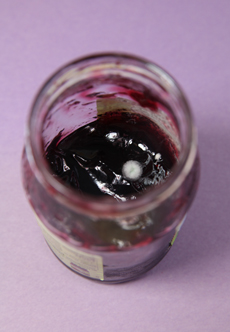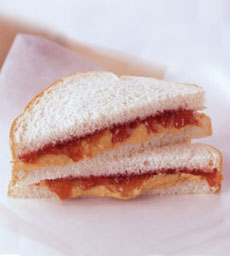TIP OF THE DAY: Mold In Jelly & Jam
 Invader alert: white mold growing in jelly. Photo by Elvira Kalviste | THE NIBBLE. |
A couple of months ago, we noticed two cottony puffs of white mold growing in a jar of Smucker’s Concord Grape Fruit Spread. We wrote to Smucker’s asking if it was safe to eat, and what caused the mold. We got a response back, but it wasn’t to the questions we asked: Thank you for contacting The J.M. Smucker Company with your inquiry regarding Smucker’s® Concord Grape Jam. We greatly appreciate and value the input we receive from our consumers and take very seriously any comments pertaining to product quality. Your experience has been brought to the attention of our quality assurance department. We want to assure you that our products are made with the best quality ingredients available and by the most carefully controlled procedures known in the food industry. We appreciate the time required to share your comments with us. As a thank you, we are in the process of sending you coupons which you should receive in the mail within two to three business weeks. We hope you will use the coupons to again try our products. If you should have further questions or need additional information, please visit us at www.smuckers.com or contact us at 888-550-9555, Monday through Friday, 9:00 a.m. to 7:00 p.m. eastern time. Sincerely, Susan |
|
|
We responded to Susan’s email with a second request to answer the questions and never heard back (nor, for the record, did we received any coupons). This week, mold appeared in a second jar of Smucker’s, the Red Raspberry Spread. So rather than try to re-contact the unhelpful customer service department at Smucker’s, we went online to search for the answers. Here’s an answer from the National Center For Home Food Preservation: A. Discard jams and jellies with mold on them. The mold could be producing a mycotoxin (a poisonous substance that can make you ill). The USDA and microbiologists recommend against scooping out the mold and using the remaining jam or jelly. Gee, you’d think Smucker’s might have warned customers against eating jelly with white mold—especially because it may well not have been their “fault” (see the next section). Perhaps they can take the information we found and paste it into a helpful customer service response. Aside from the mold—and the lack of help from Smucker’s—the spreads were delish. |
||
|
HOW TO PREVENT MOLD FROM GROWING ON JELLY AND JAM Typically, jelly and jam don’t develop mold on their own, because of the high acid of the fruit and the preservative action of the sugar. But mold spores can sometimes enter a jelly jar via contamination from a utensil that was previously used on another foodstuff—the bread for example. A microscopic piece of bread with a mold spore can adhere to the spoon or knife when you spread the jelly on the bread. We refrigerate open jars, and we’re especially cautious of cross-contamination, using a separate spoon for the jelly. But it is possible that when we spread the first spoonful of jelly on the bread, it picked up a microscopic mold spore that got introduced to the jar when we went for a second spoonful. |
 A jar can get mold contamination from a spore of bread. Photo courtesy Peanut Butter & Co. |
|
|
So today’s tip is: Don’t double dip that spoon or knife. And toss out a jar with mold. WHEN YOU CAN KEEP FOODS WITH MOLD There are thousands, if not millions, of different types of mold, from beneficial ones like penicillium (which is used to make the mold in blue cheeses) to toxic ones. Experts warn that scooping out the visible mold is not a solution, since the mold shoots microscopic tendrils deep into the foodstuff. According to the U.S. Department of Agriculture, you can save hard cheeses, firm fruits and vegetables by cutting out at least an inch around and underneath the mold spot. But the organization advises you to toss baked goods, bread, casseroles, grain, jams and jellies, legumes, meat, nuts, pasta, peanut butter, soft cheeses, soft fruits and vegetables, sour cream, yogurt and other foods. The list of what you can keep is easy to remember because it’s so brief: hard cheeses, fruits and vegetables. Bid adios to everything else.
|
||


